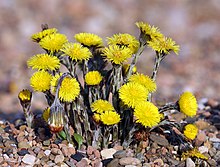Tussilago
| Coltsfoot | |
|---|---|
 |
|
| Scientific classification | |
| Kingdom: | Plantae |
| (unranked): | Angiosperms |
| (unranked): | Eudicots |
| (unranked): | Asterids |
| Order: | Asterales |
| Family: | Asteraceae |
| Subfamily: | Asteroideae |
| Tribe: | Senecioneae |
| Genus: |
Tussilago L. |
| Species: | T. farfara |
| Binomial name | |
|
Tussilago farfara L. |
|
| Synonyms | |
|
|
Tussilago farfara, commonly known as coltsfoot, is a plant in the groundsel tribe in the daisy family Asteraceae, native to Europe and parts of western and central Asia. The name "tussilago" is derived from the Latin tussis, meaning cough, and ago, meaning to cast or to act on. It has had uses in traditional medicine, but the discovery of toxic pyrrolizidine alkaloids in the plant has resulted in liver health concerns.
Tussilago farfara is the only accepted species in the genus Tussilago, although more than two dozen other species have at one time or another been considered part of this group. Most of them are now regarded as members of other genera (Chaptalia, Chevreulia, Farfugium, Homogyne, Leibnitzia, Petasites, Senecio).
Coltsfoot is a perennial herbaceous plant that spreads by seeds and rhizomes. Tussilago is often found in colonies of dozens of plants. The flowers, which superficially resemble dandelions, open on leafless stems in early spring before the leaves appear. The leaves, which resemble a colt's foot in outline appear after the flowers have set seed and wither and die in the early summer. The plant is typically 10–30 cm in height. The leaves have angular teeth on their margins.
Coltsfoot is widespread across Europe, Asia, and North Africa, from Svalbard to Morocco to China and the Russian Far East. It is also a common plant in North America and South America where it has been introduced, most likely by settlers as a medicinal item. The plant is often found in waste and disturbed places and along roadsides and paths. In some areas it is considered an invasive species.
...
Wikipedia
